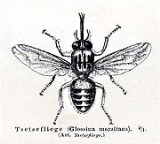
Tsetse fly
Overview
Tsetse sometimes spelled tzetze and also known as tik-tik flies, are large biting flies that inhabit much of mid-continental Africa
between the Sahara
and the Kalahari deserts. They live by feeding on the blood
of vertebrate
animals and are the primary biological vectors of trypanosomes, which cause human sleeping sickness and animal trypanosomiasis, also known as nagana
. Tsetse include all the species in the genus
Glossina, which are generally placed in their own family, Glossinidae.
Tsetse have been extensively studied because of their disease transmission.
Africa
Africa is the world's second largest and second most populous continent, after Asia. At about 30.2 million km² including adjacent islands, it covers 6% of the Earth's total surface area and 20.4% of the total land area...
between the Sahara
Sahara
The Sahara is the world's second largest desert, after Antarctica. At over , it covers most of Northern Africa, making it almost as large as Europe or the United States. The Sahara stretches from the Red Sea, including parts of the Mediterranean coasts, to the outskirts of the Atlantic Ocean...
and the Kalahari deserts. They live by feeding on the blood
Blood
Blood is a specialized bodily fluid in animals that delivers necessary substances such as nutrients and oxygen to the cells and transports metabolic waste products away from those same cells....
of vertebrate
Vertebrate
Vertebrates are animals that are members of the subphylum Vertebrata . Vertebrates are the largest group of chordates, with currently about 58,000 species described. Vertebrates include the jawless fishes, bony fishes, sharks and rays, amphibians, reptiles, mammals, and birds...
animals and are the primary biological vectors of trypanosomes, which cause human sleeping sickness and animal trypanosomiasis, also known as nagana
Nagana
Nagana, also known as nagana pest or animal African trypanosomiasis, is a disease of vertebrate animals. The disease is caused by trypanosomes of several species in the genus Trypanosoma. The trypanosomes infect the blood of the vertebrate host, causing fever, weakness, and lethargy, which lead to...
. Tsetse include all the species in the genus
Genus
In biology, a genus is a low-level taxonomic rank used in the biological classification of living and fossil organisms, which is an example of definition by genus and differentia...
Glossina, which are generally placed in their own family, Glossinidae.
Tsetse have been extensively studied because of their disease transmission.

